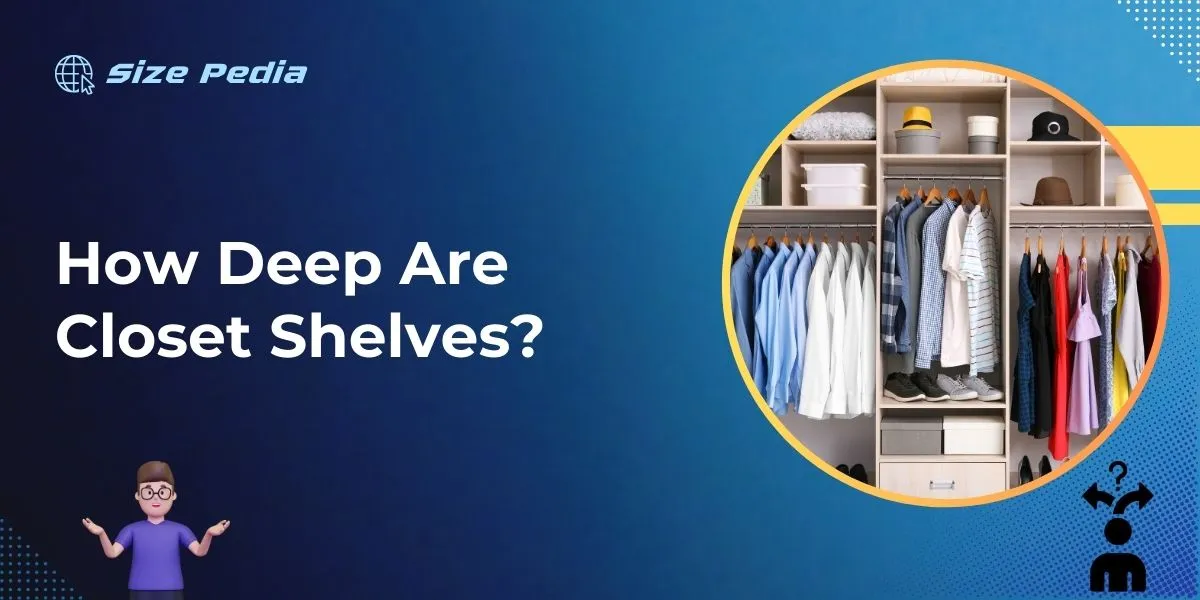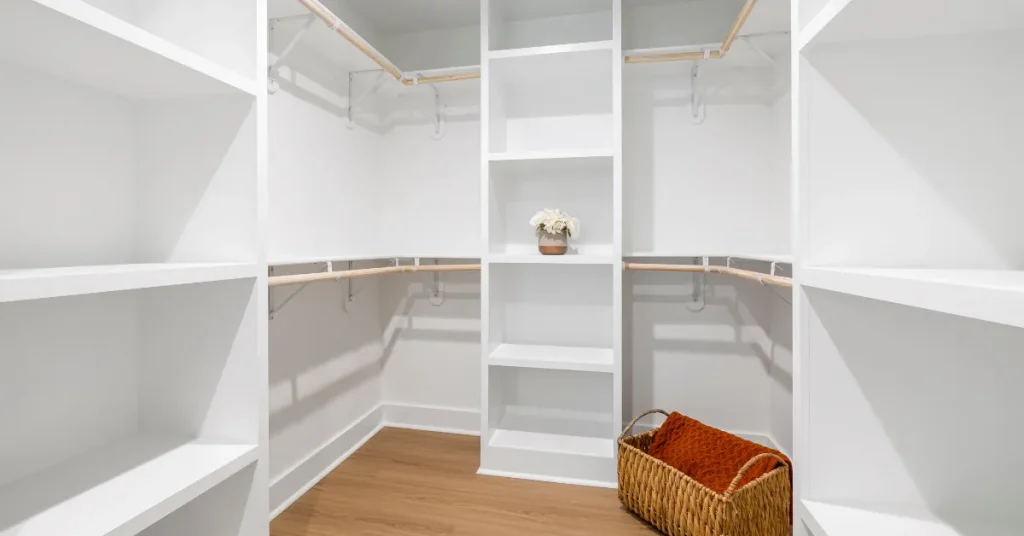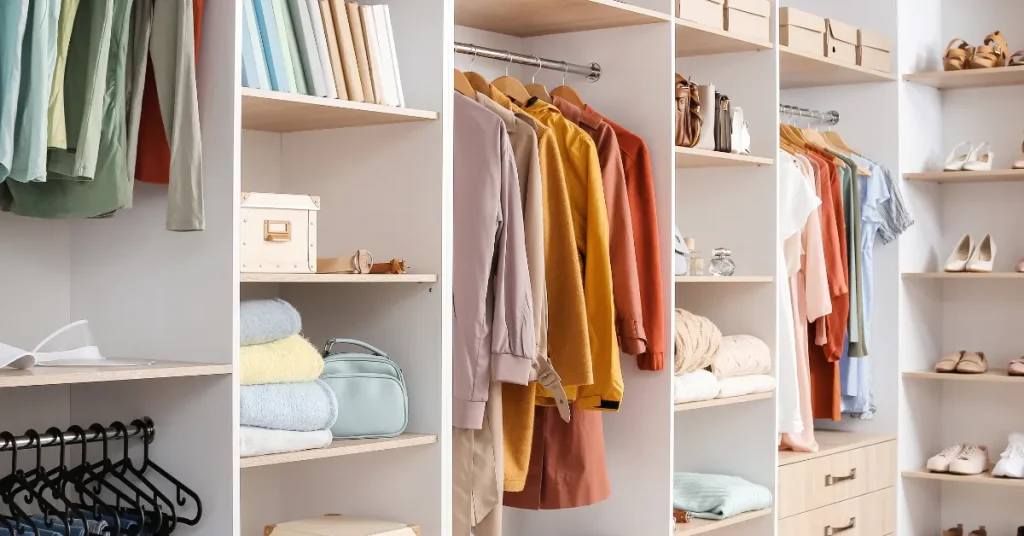Closet shelves typically range from 12 to 24 inches in depth. Standard closets often feature 12-inch deep shelves.
Designing or organizing a closet space requires consideration of both practicality and aesthetic appeal. Closet shelf depth is a crucial detail that can greatly impact the functionality and efficiency of your storage.
Closets meant for storing clothes and everyday items usually have shallower shelves, whereas those intended for bulkier items, such as linens or large boxes, might have deeper shelves.
The depth of your closet shelves should align with the items you plan to store, ensuring that everything is accessible and neatly organized. Thus, selecting the right shelf depth is an important step in maximizing the usability and convenience of your closet space.

Measuring The Depth: Essential Factors
When planning your dream closet, depth is crucial. Right measurements make a big difference. Let’s look at what shapes closet shelf depth.
Room Size And Shape
Room dimensions guide shelf depth. Space matters. Smaller rooms need slimmer shelves. It’s all about balance.
A quick tip: Measure twice, install once. Grab a tape. Start measuring your closet space. Take note of the numbers. They will help you decide.
- Less than 5 feet wide: Consider shelves around 11-12 inches deep.
- 5 feet and more: You might go up to 14 inches.
Content Of Your Closet
The stuff you store plays a part. Need to fit bulky jackets or just thin shirts? Answer this first.
Make a list. What’s going in? Sweaters might need more depth than t-shirts. Keep this in mind:
| Item Type | Recommended Depth |
| Shirts and Tops | 11-12 inches |
| Coats and Jackets | Up to 14 inches |
| Accessories | 9-10 inches |
Remember, adjust for what you own. Consider dividers for small items. They keep things neat and accessible.
Standard Depth Sizes: Comparison
When planning the perfect closet, understanding the standard depth sizes is crucial. These measurements determine how much space you’ll have for storage. Let’s dive into the common dimensions and weigh their pros and cons.
What’s Commonly Used
Closet shelves typically come in various standard sizes. The 12-inch depth serves basic needs. It holds a stack of folded clothes nicely.
For more bulky items, a 16-inch depth works well. It’s great for larger objects, like comforters. Some closets go up to 24 inches for even more space. This size is ideal for items such as suitcases.
| Shelf Depth | Common Use |
| 12 inches | Folded clothes, towels |
| 16 inches | Jackets, bedding |
| 24 inches | Suitcases, storage bins |
Pros And Cons Of Variations
Every closet shelf depth has its strengths and weaknesses.
- 12-inch shelves save space. They keep your closet looking streamlined. On the downside, they might be too small for some items.
- 16-inch shelves offer versatility. They’re good for an array of things. Yet, they can make a closet feel more cramped.
- 24-inch shelves provide maximum storage. They’re excellent for large containers. However, they require a bigger closet to fit properly.
Choose wisely based on what you’ll store. Consider your closet’s size as well. The right choice will make your closet both functional and comfortable.
Customizing For Optimal Storage
Imagine opening your closet to see every item neatly arranged and easily accessible. The secret? Customized shelf depths tailored to your belongings.
This magic starts by evaluating your storage needs and carefully designing your closet shelves. Let’s embark on a journey to create your perfect closet space.
Assessing Your Needs
Before diving into shelf customization, consider what you’ll store. Your needs dictate the depth of your closet shelves. Do you have bulky items or a collection of shoes? Think about each category:
- Folded clothes – typically require 12 inches of depth.
- Shoes – do best on 9 to 12-inch shelves.
- Bulk items – like blankets, need deeper shelves, around 15 to 24 inches.
Assess your wardrobe and belongings for a clear picture of ideal shelf sizes.
Design Considerations
As you plan shelf depths, keep the following factors in bold:
| Item | Recommended Depth |
| Standard Clothing | 12 inches |
| Coats and Outerwear | 15 to 24 inches |
| Accessories | 6 to 9 inches |
Keep these measurements in mind and blend them with your style requirements. Consider adjustable shelving for flexibility, ensuring you optimize your closet for today and tomorrow.
Maximizing Space In Narrow Closets

Many homes face the puzzle of narrow closets. The key lies in smart shelf depths. Making every inch count in a slim space takes crafty ideas.
Innovative Shelving Solutions
Think out of the box with shelving that transforms narrow closets. Adjustable shelves shift for custom fits. Sliding bins create flexible storage. Try these:
- Pull-out shelves – Easy access in a tight spot
- Corner racks – Utilize overlooked angles
- Stackable units – Build storage up
Utilizing Vertical Space
Height is your best friend in narrow closets. Go vertical to expand storage. Install shelves from floor to ceiling. Hang hooks on the back of doors. Use these:
- High shelves – Keep rarely used items up top
- Wall-mounted baskets – Grasp essentials quickly
- Hanging rods – Double your hanging space
Remember, in narrow closets, smart shelf depth makes a big difference. Aim for 12 to 16 inches where clothes hang. For folded items, 9 to 12 inches works well. This ensures everything fits and is within reach.
| Item Type | Shelf Depth Range |
| Hanging Clothes | 12 to 16 inches |
| Folded Clothes | 9 to 12 inches |
Accessibility And Convenience
Closet shelves transform the organization game with a balance of accessibility and convenience. Striking this balance allows for smoother mornings and less clutter.
Reaching For The Heights
Optimizing closet space often means utilizing vertical areas. Upper shelves should be within reach without a stool.
Typically, a height of 84 to 96 inches offers a reachable zone for most people. Seated users find 48 inches as a comfortable high point.
Below are standard dimensions:
| User | Max Height (inches) |
| Average Height Individual | 84 to 96 |
| Seated User | 48 |
- Shelves above 96 inches need a step tool.
- Place rarely used items higher up.
- Keep daily items between waist and shoulder level.
Drawer And Pull-out Options
Drawers and pull-outs enhance ease of access. These options prevent items from getting lost in the back. Consider pull-out shelves between 18 and 24 inches deep for best use.
- Install drawers for undergarments and accessories.
- Use pull-out shelves for folding clothes.
- Opt for drawer dividers to sort small items.
The right mix of shelving, drawers, and hanging space ensures everything has a place. A well-designed closet responds to personal habits and height.
Maintaining Organization And Style

Maintaining organization and style in your closet is more than just a way to find your clothes quickly. It’s about maximizing space efficiency and enhancing the room’s look.
Deep closet shelves can be a game-changer, offering ample room to sort and store your belongings. Yet, they come with their unique set of challenges.
Without smart strategies, deep shelves quickly become cluttered. Let’s dive into how to keep them both organized and stylish.
Labeling And Dividers
Bold use of labels and dividers turns deep shelves from chaos into a functional storage hub.
- Labels: Mark bins and boxes with simple, clear language.
- Dividers: Split shelves to keep items upright and accessible.
With every article having a designated spot, you’ll never shuffle through stacks of clothes looking for a single item again.
Aesthetic Choices For Shelf Design
Shelf style matters as much as its utility. A pleasing design encourages you to keep it neat.
| Material | Color | Texture |
| Wood, metal, glass | Match room’s palette | Smooth, woven, rustic |
Select materials and hues that complement your space. Add some personality with unique textures.
FAQs About How Deep Are Closet Shelves
What Is The Standard Depth For Closet Shelves?
The standard depth for closet shelves typically ranges between 12 to 24 inches. This size accommodates most clothing and storage items, allowing for efficient use of space and accessibility.
Can Closet Shelf Depth Be Customized?
Yes, closet shelf depth can be customized to meet specific storage needs. Some people opt for deeper shelves for bulky items or shallower ones for a better view of contents.
Does Shelf Depth Vary For Different Closet Types?
Shelf depth can vary for different closet types. Reach-in closets often have 11-15 inch deep shelves, while walk-ins might feature deeper shelves up to 24 inches to provide more storage space.
What Factors Influence The Ideal Closet Shelf Depth?
Factors that influence the ideal closet shelf depth include the closet’s size, the items being stored, personal accessibility needs, and aesthetic preferences. Considering these elements ensures optimal shelf depth and functionality.
Conclusion
Determining the depth of your closet shelves is essential for maximizing storage space while maintaining accessibility.
Standard depths suit most needs, but custom solutions cater to unique requirements. Remember, the key lies in balancing depth with utility for a clutter-free, organized closet.
Perfect your space with shelves that fit your life.
Resources:
1. https://www.ada.gov/law-and-regs/design-standards/1991-design-standards/
